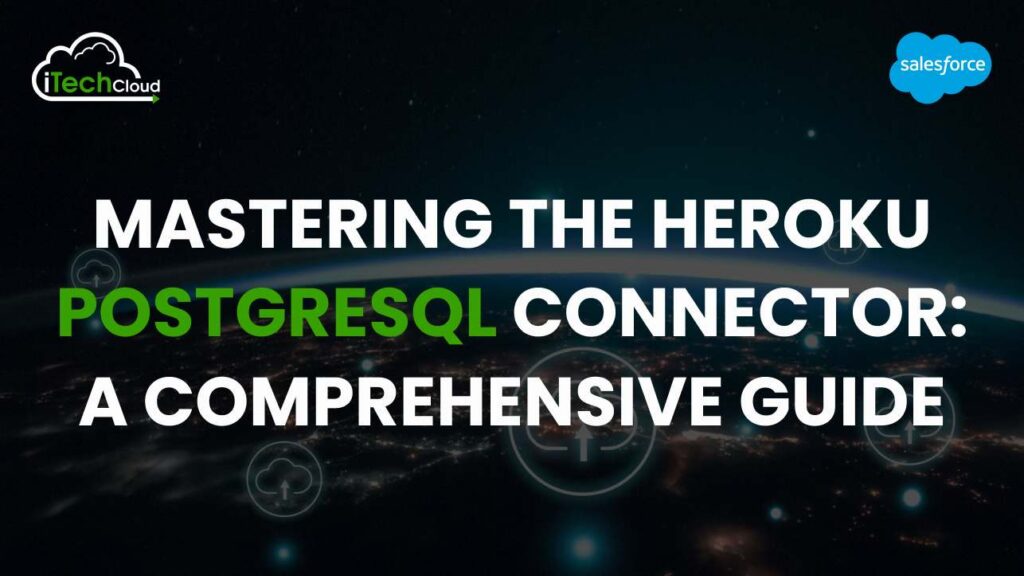Mastering the Heroku PostgreSQL Connector: A Comprehensive Guide

Heroku PostgreSQL is a cloud-based database service offered by Heroku, providing a fully managed, scalable PostgreSQL database for applications. The Heroku PostgreSQL Connector allows seamless integration between Heroku-hosted applications and PostgreSQL databases. This comprehensive guide aims to provide an in-depth understanding of the Heroku PostgreSQL Connector, covering its setup, configuration, management, and optimization for various use cases.
Table of Contents
Introduction to Heroku PostgreSQL Connector
Heroku PostgreSQL Connector is renowned for its ease of use, reliability, and powerful features. It offers several plans, from free hobby databases to high-performance databases suitable for large-scale production applications. Key features include automated backups, failover support, encryption, and powerful monitoring tools.
Setting Up the Heroku PostgreSQL Connector
Creating a Heroku Application and PostgreSQL Database
- Sign up for a Heroku account if you haven’t already.
- Create a new application via the Heroku dashboard or CLI.
- Add a PostgreSQL database to your application using the
heroku addons:create heroku-postgresqlcommand or via the Heroku dashboard.
Connecting to the Database
- Obtain the database URL from the Heroku dashboard under the “Resources” tab or by running
heroku config:get DATABASE_URL. - Use this URL to connect to your PostgreSQL database using any PostgreSQL client, such as
psql, pgAdmin, or an application-specific ORM (e.g., SQLAlchemy for Python, ActiveRecord for Ruby).
Configuring the Heroku PostgreSQL Connector
Environment Variables
- Heroku uses environment variables to manage configuration settings. The
DATABASE_URLvariable is automatically set and can be accessed within your application code. - Additional configuration settings can be added via the Heroku dashboard or using the
heroku config:setcommand.
Database Configuration
- Customize your PostgreSQL database settings to optimize performance for your specific use case. This includes adjusting parameters such as
work_mem,maintenance_work_mem,shared_buffers, andmax_connections.
Managing the Heroku PostgreSQL Database
Backup and Restore
- Heroku PostgreSQL provides automated daily backups, but you can also create manual backups using the
pg:backupscommands. - Restoring a backup can be done using the
pg:backups:restorecommand, specifying the backup ID and the target database.
Scaling the Database
- Heroku allows you to scale your database vertically by upgrading to a larger plan or horizontally by adding read replicas.
- Upgrading the plan is straightforward via the Heroku dashboard or CLI, while adding read replicas can be done to distribute read traffic and improve performance.
Monitoring and Logging
- Heroku PostgreSQL includes robust monitoring tools that provide insights into database performance, such as response times, cache hit rates, and query performance.
- Enable and configure logging to capture detailed information about database operations, which can help in debugging and performance tuning.
Optimizing Performance
Indexing
- Proper indexing is crucial for database performance. Analyze your query patterns and create indexes on frequently queried columns.
- Use tools like the PostgreSQL
EXPLAINcommand to understand query execution plans and identify opportunities for optimization.
Query Optimization
- Optimize your SQL queries by avoiding common pitfalls like SELECT *, using JOINs judiciously, and leveraging PostgreSQL-specific features like window functions and CTEs (Common Table Expressions).
- Regularly analyze and tune your queries to ensure they perform efficiently as your data grows.
Caching
- Implement caching strategies to reduce database load and improve response times. Use in-memory stores like Redis or Memcached to cache frequently accessed data.
- Heroku provides Redis as an add-on, which can be easily integrated into your application.
Security Best Practices
Data Encryption
- Heroku PostgreSQL supports SSL encryption for data in transit. Ensure your application is configured to use SSL when connecting to the database.
- Use encryption at rest by leveraging PostgreSQL’s built-in encryption features or third-party tools.
Access Control
- Implement robust access control mechanisms by creating distinct database roles with appropriate permissions.
- Avoid using the superuser role for application connections. Instead, create specific roles with the minimum required privileges.
Regular Security Audits
- Conduct regular security audits to identify and address potential vulnerabilities.
- Stay updated with the latest security patches and PostgreSQL releases to ensure your database is protected against known threats.
Advanced Features
Full-Text Search
- PostgreSQL offers powerful full-text search capabilities. Leverage these features to implement advanced search functionality within your application.
- Configure and optimize full-text search indexes to ensure fast and accurate search results.
Geospatial Data
- PostgreSQL, with its PostGIS extension, supports geospatial data types and functions. Use PostGIS to store and query geospatial data for applications like mapping and location-based services.
- Optimize geospatial queries by creating spatial indexes and leveraging PostGIS functions.
JSON and NoSQL Capabilities
- PostgreSQL supports JSON data types, allowing you to store and query semi-structured data.
- Use JSON functions and operators to manipulate JSON data and integrate it seamlessly with your relational data.
Troubleshooting Common Issues
Connection Issues
- Ensure your application is correctly configured to connect to the PostgreSQL database. Check environment variables, network settings, and firewall rules.
- Use Heroku’s diagnostic tools and logs to identify and resolve connection problems.
Performance Degradation
- Identify performance bottlenecks by monitoring query performance and resource usage.
- Use tools like
pg_stat_statementsand the Heroku PostgreSQL dashboard to diagnose and address performance issues.
Data Corruption
- Regularly backup your database to mitigate the risk of data corruption.
- In the event of data corruption, restore from a recent backup and investigate the root cause to prevent recurrence.
Conclusion
Mastering the Heroku PostgreSQL Connector involves understanding its setup, configuration, management, and optimization. By following best practices and leveraging advanced features, you can ensure your Heroku PostgreSQL database performs optimally, scales efficiently, and remains secure. Regular monitoring, maintenance, and optimization will help you get the most out of your Heroku PostgreSQL database, providing a robust foundation for your applications.

